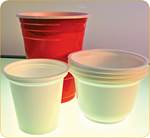MuCell Extrusion Gains Dow and Styron Film and Sheet Technology
MuCell Extrusion LLC, Woburn, Mass., made two moves last month that further expanded its capabilities in flat film and sheet foaming.
MuCell Extrusion LLC, Woburn, Mass., made two moves last month that further expanded its capabilities in flat film and sheet foaming. First, it will exclusively license Dow’s thin foamed films patent family, using MuCell microcellular foaming technology to create physically foamed films for all film applications. Dow Chemical Co., Midland, Mich., will continue to offer resins specially formulated to optimize foaming results, while MuCell will provide technology transfer, equipment, and technical support.
This agreement follows a similar move earlier this year, wherein Dow and MuCell Extrusion LLC reached an agreement for MuCell Extrusion to exclusively license Dow’s patent family on flat sheet technology (see April Starting Up).
Shortly after the latest Dow announcement, MuCell and Styron LLC, Berwyn, Pa., reached an agreement giving MuCell access to Styron’s patent portfolio for extrusion of polystyrene, ABS, and SAN. This agreement gives MuCell Extrusion and its customers exclusive rights to Styron patents on sheet technology for a wide variety of applications. (Styron was part of Dow until it was spun off to create an independent company in June 2010.)
The combination of Styron’s new CO2RE polystyrene foam-sheet technology (see Aug. 2011 Close Up) and MuCell’s expertise is expected to help processors improve their competitive advantage in a shorter time frame.
Related Content
-
Follow These Tips to Fire Up Your Cold Blown Film Line
Firing up a cold blown-film line after a shutdown involves multiple pieces of equipment that all interact. Here’s a look at those components individually and some best practices on how to get your line up and running as quickly and safely as possible.
-
Film Extrusion: Boost Mechanical Properties and Rate of Composting by Blending Amorphous PHA into PLA
A unique amorphous PHA has been shown to enhance the mechanical performance and accelerate the biodegradation of other compostable polymers PLA in blown film.
-
Breaking News From NPE2024
Here is a firsthand report of news in injection molding, extrusion, blow molding and recycling not previously covered.

